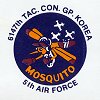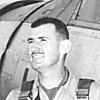
1/7518 Captain L.K. (Keith) Hatfield

 | SHOT DOWN 1/7518 Captain L.K. (Keith) Hatfield |  |
The formation was officially designated "The Mosquitos", a name derivedfrom the term used by the Chinese to describe the sound made by Groupaircraft, which was quite distinctive. The aircraft being operated by the Mosquitos were mainly T6Gs. equippedwith smoke rockets for the purpose of marking targets on the ground. Therole of the Formation was the direction of Close Support Fighter Bombingin close proximity to our own forces. The enemy were often dug-in only afew hundred metres from our own lines, and bombs had to be placed withgreat accuracy to avoid getting onto 'Friendlies'. In consequence, the marking had to be absolutely 'spot-on', and thebombing aircraft strictly controlled. These requirements also demandedthat the Mosquito fly low and slow. The enemy had for some time tended to disregard the presence of theMosquito during Air-Strikes, and had concentrated their fire on the muchmore difficult target presented by the Bombing aircraft, but once theyrealized that if the Mosquito was shot down the strike would either bedelayed, or put in elsewhere, they concentrated much of their fire ontotheMossie. With much improved ACK ACK they set about giving us a'Right Royal' pasting whenever we showed up. We suffered heavily inconsequence, and often went home to base full of holes of one kind oranother. Life was anything but boring. The area of operations taken in by the Mosquitos extended from one sideof the Country to the other, taking in the Main Line of Resistance, andextending further North to Forward Bomb Line. Peace negotiations had been dragging on interminably at Panmunjom, as theenemy sought to regain territory lost on the Eastern Front, beforeaccepting a Cease Fire. Their efforts were creating a lot of 'Heat in thekitchen' so to speak. Having been assigned to a sector of the Front at Briefing, the Mosquitocrews would ready-up, and depart K47, in time to make RV in the targetarea, as required. At 0600 hours on the morning of 17th May 1953, Captain Frank E. Winner,with whom I had not previously flown, and I attended the first briefing ofthe day, and were assigned to the 'remote Sector', which was on thecentral Front. We were allocated LTA5555 ( 'Triple Nickel' ), an aircraftfor which I had an affection, having flown in her on numerous occasionswithout incident. We were to use the call-sign 'Mosquito Exile One'. Wetook off on time, and on approach 'Remote Control', called 'in-bound' andwere directed to an area known as the 'Dog's Head', and en-route were giventhe target Co-ordinates for the Strike we were to put in, once we had thefighters in the area.
I discussed the target with Winner and we flew over to take a 'look-see.'I was satisfied, but he wasn't, so we went back for another look, and thatwas when the 'fun started.' As we orbited over the target, and straightened up to return to the MLR,wait for the fighters, there was a loud thump, the aircraft bouncedupwards, and acrid smelling white smoke quickly filled the cockpit. Winnercracked the canopy open, and as he did so the entire space from thefirewall to the rear cockpit became a blazing inferno. With no time to talk he stood up, and bailed out over the port side. As the flames were then extending to the tail plane on the port side, Ileft the aircraft from the starboard, but because of the heat, did notexit properly, and found myself on the horizontal stabiliser - my firstexperience of that kind ( and hopefully my last too!!) My next concern, once my descent was under control, was to look forfriendlies, and establish which way I would have to go to evade capture. Iwas relieved to find a friendly wind was carrying me in the direction Ishould go. I had just begun to congratulate myself on how well things weregoing when I became aware that the air around me was cracking with thesounds of fire being directed at me by some of my 'Oriental Customers' towhom I had planned a delivery. There was little I could do there and then, but hope they were all 'crookshots', but when I hit Mother Earth, and he put a burst into the base of atree about 20 yards away, I decided I'd had enough of his company, and Itook off for home and Mother, at a great rate of knots, ( Move aside JohnLandy I'm coming through!) I didn't have all that far to go before I drew the attention of aBattalion of the 3rd Capitol ROK Division which was holding that sectionof the front above where I had come down. Their assistance at that pointconsisted of shouting 'Hubba, Hubba,' which translated means 'Go likebuggery.' I thought that was what I had been doing! I eventually found my way up to the top of the Ridge, having negotiated aMine field en-route, and was then taken to the Battalion command post,where the colonel was kind enough to allow me to sit in his 'Hutchi' andget my breath back, and take stock of the situation. I asked for Winner and was told his chute had caught on a cliff face, andas the enemy were shooting at him suspended there, he had released hisharness, and fallen some distance onto rocks. Therefore there had been a fire fight between the enemy and friendlies todecide who would get him and friendlies won - they said he would soonappear. In the meantime I tried to make contact with 'Remote Control' using thecall sign 'Dodo Exile One,' without success. (A Dodo is a bird thatdoesn't fly, and we were authorized to use that call in suchcircumstances). When Winner finally arrived he was a stretcher case, and in a very badway. He had smacked into the tail plane front on, and as was later found,had ruptured his spleen. He also had bad burns, and a broken arm fromfalling amongst the rocks at the base of the cliff. In due course a Bell 47J, suitably equipped, flew in and we were taken to44 MASH, with Frank strapped to a litter on the side. Frank took some time to mend, and was eventually evacuated back home. Istayed the night at the MASH, and the next day Major HANK HANSEN, C.O. ofthe 6148TH flew in, and took me back to K47 where I also was hospitalizedin our own sick Bay. I was grounded for a time, due to burns received when my flying suitmelted with the heat. During that time I accepted an invitation from a'friend' to go after an F86 Pilot who had been shot down on the Centralfront. We found him alright, but we copped a burst through the starboardmainplane, and nearly joined him there and then. But that is a story foranother day. The foregoing episode and others relating to the . Mosquitos', appearedin Argosy Magazine, entitled 'Slow Run to Hell'. The episode above wasalso used in an ABC radio Broadcast Series to do with 'Our Servicemen onactive Duty.' Post script: Keith returned to active duty and completed 75 missions. Hewas no stranger to war having served as an Infantry Platoon Commander inNew Guinea and as a Platoon Commander and Company Commander on attachmentto the Queen's Own Cameron Highlanders in Burma during World War 11. ThisBritish army service extended to the Malayan insurgancy in 1949 prior tohis return to Australia. A retired Colonel, Keith lives in Park Orchards Victoria. His civilianworking revolved around private flying and the Aviation industry, at 80years of age he retains his Pilots License.
|
| © Australian Album © |